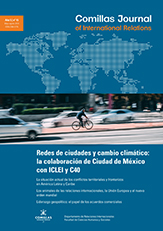Liderazgo geopolítico: el papel de los acuerdos comerciales
DOI:
https://doi.org/10.14422/cir.i15.y2019.005Palabras clave:
tratados de libre comercio, internacionalización, globalización, geopolíticaResumen
Las relaciones comerciales de carácter transnacional y la formulación de los acuerdos comerciales que configuran las mismas, constituyen piezas clave en la estrategia geopolítica de los países. Si bien la articulación de la influencia geopolítica a través del comercio no es algo nuevo, sí lo es la creciente incorporación de cláusulas no comerciales en los tratados de comercio. En este contexto, China, como potencia emergente y EE. UU., líder consolidado, están intentando introducir nuevas orientaciones en el orden económico mundial a través de la configuración y articulación del comercio.Descargas
Referencias
Aaronson, S. A., & Zimmerman, J. M. (2008). Trade Imbalance: The Struggle to Weigh Human Rights Concerns in Trade Policymaking. Cambridge and New York: Cambridge University Press.
Aggarwal, V. K., & Govella, K. (2013). Linking Trade and Security: Evolving Institutions and Strategies in Asia, Europe, and the United States. The Political Economy of the Asia Pacific. New York: Springer.
Ahnlid, A. (2013). The trade do-gooder? Linkages in EU free trade agreement negotiations. Linking trade and security, The Political Economy of the Asia Pacific. New York: Springer. DOI: https://doi.org/10.1007/978-1-4614-4765-8_10
Baccini, L., Dür, A., & Haftel, Y. Z. (2015). Imitation and innovation in international Governance: the diffusion of trade agreement design. In Trade Cooperation (pp. 167-194). Cambridge: Cambridge University Press. DOI: https://doi.org/10.1017/CBO9781316018453.010
Baier, S. L., & Bergstrand, J. H. (2004). Economic determinants of free trade agreements. Journal of International Economics, 64(1), 29-63. DOI: https://doi.org/10.1016/S0022- 1996(03)00079-5
Bhagwati, J., y Hudec, R. (1996). Fair Trade and Harmonization: Prerequisites for Free Trade. Vol. I Economic Analysis, Vol. II Legal Analysis. Cambridge: MIT Press.
Chen, M., & Joshi, S. (2010). Third-country effects on the formation of Free Trade Agreements. Journal of International Economics, 82(2), 238-248. DOI: https://doi.org/10.1016/j.jinteco.2010.06.003
Comisión Europea. (2015). Trade for all. Towards a more responsible trade and investment policy. European Commission.
DESTA. (2017). Base de datos: https://www.designoftradeagreements.org/downloads/
Dür, A., Baccini, L., & Elsig, M. (2014). The Design of International Trade Agreements: Introducing a New Database. Review of International Organizations, 9(3), 353-375. DOI: https://doi.org/10.1007/s11558-013-9179-8
Gowa, J., & y Mansfield, E. (1993): Power Politics and International Trade. The American Political Science Review, 87(2), 408-420. DOI: https://doi.org/10.2307/2939050
Hafner-Burton, E. M. (2005). Trading Human Rights: How Preferential Trade Agreements Influence Government Repression. International Organization, 59(3), 593-629. DOI: https://doi.org/10.1017/S0020818305050216
Hafner-Burton, E. M. (2009). Forced to be Good: Why Trade Agreements Boost Human Rights. Ithaca: Cornell University Press.
Horn, H., Maggi, G., & Staiger, R. (2010). Trade agreements as endogenously incomplete contracts. American Economic Review, 100(1), 394-419. DOI: https://doi.org/10.1257/aer.100.1.394
Koremenos, B., Lipson, C., & Snidal, D. (2001). The rational design of international institutions. International organization, 55(4), 761-799. DOI: https://doi. org/10.1162/002081801317193592
Krugman, P. (1997). What should trade negotiators negotiate about? Journal of Economic Literature, 35(1), 113-120.
Lake, J., & Yildiz, H. M. (2016). On the different geographic characteristics of Free Trade Agreements and Customs Unions. Journal of International Economics, 103(C), 213-233. DOI; https://doi.org/10.1016/j.jinteco.2016.09.003
Lavenex, S., & Schimmelfennig, F. (2009). EU rules beyond EU borders: theorizing external governance in European politics. Journal of European Public Policy, 16(6), 791-812. DOI: https://doi.org/10.1080/13501760903087696
Lechner, L. (2016). The domestic battle over the design of non-trade issues in preferential trade agreements. Review of International Political Economy, 23(5), 840-871. DOI: https://doi. org/10.1080/09692290.2016.1231130
Lemus, D., & Valderrey, F. (2017). La Nueva Ruta de la Seda y la diplomacia internacional de negocios. Comillas Journal of International Relations, (10), 47-64. DOI: https://doi. org/10.14422/cir.i10.y2017.004.
Mansfield, E. D., & Pevehouse, J. C. (2000). Trade Blocs, Trade Flows, and International Conflict. International Organization, 54(04), 775-808. DOI: https://doi. org/10.1162/002081800551361
Milewicz, K., Hollway, J., Peacock, C., & Snidal, D. (2016). Beyond trade: The expanding scope of the non-trade agenda in trade agreements. Journal of Conflict Resolution. DOI: https://doi.org/10.1177%2F0022002716662687
Postnikov, E. (2014). The design of social standards in EU and US preferential trade agreements. In Handbook of the International Political Economy of Trade, Handbooks of Research on International Political Economy series (pp. 531-549). Cheltenham: Edward Elgar Publishing. DOI: https://doi.org/10.4337/9781781954997.00032
PWC. (2016). Los Tratados de Libre Comercio en la economía mundial. Consenso Económico Segundo Trimestre de 2016. http://www.pwc.es/es/publicaciones/economia/assets/consenso-economico-segundo-trimestre-2016.pdf
Vogel, D. (2013). Global trade linkages: national security and human security. In Linking Trade and Security, The Political Economy of the Asia Pacific (pp. 23-48). New York: Springer. DOI: https://doi.org/10.1007/978-1-4614-4765-8_2
Descargas
Publicado
Número
Sección
Licencia
Los autores de artículos aceptados en Comillas Journal of International Relations conservan los derechos de propiedad intelectual sobre sus trabajos y otorgan a la revista los permisos de distribución y comunicación pública de los mismos, consintiendo que se publiquen bajo una licencia Creative Commons Atribución-NoComercial-SinDerivadas 4.0 Internacional. Se recomienda a los autores publicar su trabajo en Internet (por ejemplo en páginas institucionales o personales, repositorios, etc.) respetando las condiciones de esta licencia y citando debidamente la fuente original.













